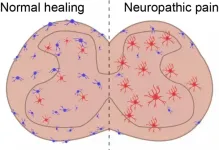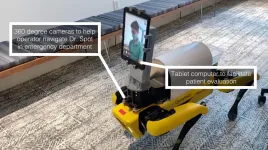INFORMATION:
A new model can predict the evolution of antibiotic resistance in bacteria
2021-03-04
(Press-News.org) A team of scientists from the University of Cologne (Germany) and the University of Uppsala (Sweden) has created a model that can describe and predict the evolution of antibiotic resistance in bacteria. Resistance to antibiotics evolves through a variety of mechanisms. A central and still unresolved question is how resistance evolution affects cell growth at different drug concentrations. The new model predicts growth rates and resistance levels of common resistant bacterial mutants at different drug doses. These predictions are confirmed by empirical growth inhibition curves and genomic data from Escherichia coli populations. The study has been published in the journal 'Nature Ecology & Evolution'.
Antibiotic resistance arises through evolution. Bacteria change their genome and become less sensitive to drugs. Resistance mutations, however, often come at a cost to bacteria in the absence of antibiotics. The mutant cells have higher growth in the presence of the drug, but in a drug-free environment, their growth rate is lower than that of the antibiotic-susceptible wild type. 'The cells have to optimize their decision about resistance. We have created a model that describes this process,' said main author Fernanda Pinheiro from the Institute of Biological Physics at the University of Cologne.
The process can be compared to building and marketing houses, she explained: 'Houses are built with a fixed budget. Depending on the location, you have to invest more or less to insulate against cold and, in return, make compromises in design. But an ugly house also sells poorly. Similarly, the evolution of bacteria determines how much of its protein content is invested in antibiotic resistance.'
This prediction is very difficult because the bacterium often has multiple options to build defences. 'Surprisingly, our model successfully predicts which mechanisms of antibiotic resistance are likely to evolve in a bacterial population under certain conditions,' Pinheiro said. In keeping with the analogy of building a house: To keep the house warm, one can invest in thick windows or in heating technology. Which option is better depends on the whole system, because in a bacterium, different parts of the cell are interdependent. 'Mutations change these parts and leave traces in the growth pattern that, in turn, can be used to learn and ultimately predict evolution.'
Resistant bacteria threaten the antibiotic treatment of millions of people worldwide and cause hundreds of thousands of deaths each year. In 2019, the WHO included antibiotic resistance in its list of the top 10 threats to global health. Therefore, insights about the evolution of antibiotic resistance can help identify optimal treatment protocols, drug targets, and new antibiotic candidates. The new knowledge can be useful in making better decisions about antibiotic use. 'If we can anticipate what bacteria are likely to do under different circumstances, we can think more specifically about interventions to avoid the evolution of resistance,' Pinheiro said.
ELSE PRESS RELEASES FROM THIS DATE:
WOX9: A jack of all trades
2021-03-04
Over evolutionary time scales, a single gene may acquire different roles in diverging species. However, revealing the multiple hidden roles of a gene was not possible before genome editing came along. Cold Spring Harbor Laboratory (CSHL) Professor and HHMI Investigator Zach Lippman and CSHL postdoctoral fellow Anat Hendelman collaborated with Idan Efroni, HHMI International Investigator at Hebrew University Faculty of Agriculture in Israel, to uncover this mystery. They dissected the activity of a developmental gene, WOX9, in different plants and at different moments in development. Using genome editing, they found that without changing the protein produced by the gene, they ...
Scientists find new cell type implicated in chronic pain, inflammation
2021-03-04
CHAPEL HILL, NC - One of the hallmarks of chronic pain is inflammation, and scientists at the UNC School of Medicine have discovered that anti-inflammatory cells called MRC1+ macrophages are dysfunctional in an animal model of neuropathic pain. Returning these cells to their normal state could offer a route to treating debilitating pain caused by nerve damage or a malfunctioning nervous system.
The researchers, who published their work in Neuron, found that stimulating the expression of an anti-inflammatory protein called CD163 reduced signs of neuroinflammation in the spinal cord of mice with neuropathic pain.
"Macrophages are a type of immune cell that are found in the blood and in tissues ...
Prevalence of inflammatory heart disease among pro athletes with prior COVID-19 infection who received systematic return-to-play cardiac screening
2021-03-04
What The Study Did: In this study of return-to-play cardiac testing performed on 789 professional athletes with COVID-19 infection, imaging evidence of inflammatory heart disease that resulted in restriction from play was identified in five athletes (0.6%). No adverse cardiac events occurred in the athletes who underwent cardiac screening and resumed professional sports participation.
Authors: David J. Engel, M.D., of Columbia University Irving Medical Center in New York, is the corresponding author.
To access the embargoed study: Visit our For The Media website at this link https://media.jamanetwork.com/
(doi:10.1001/jamacardio.2021.0565)
Editor's Note: The article includes conflict of ...
SARS-CoV-2 on ocular surfaces in patients with COVID-19 from Italy
2021-03-04
What The Study Did: Using reverse transcription-polymerase chain reaction testing, this study found that SARS-CoV-2 was present on the ocular surface in 52 of 91 patients with COVID-19 (57.1%). The virus may also be detected on ocular surfaces in patients with COVID-19 when the nasopharyngeal swab is negative.
Authors: Claudio Azzolini, M.D., of the University of Insubria in Varese, Italy, is the corresponding author.
To access the embargoed study: Visit our For The Media website at this link https://media.jamanetwork.com/
(doi:10.1001/jamaophthalmol.2020.5464)
Editor's ...
Frequency of vitreoretinal surgical procedures in US during COVID-19 pandemic
2021-03-04
What The Study Did: This study of more than 526,000 procedures across 17 institutions reports a significant decrease in the use of lasers and cryotherapy, retinal detachment repairs and other vitrectomies, beginning mid-March last year and lasting at least until May.
Authors: Mark P. Breazzano, M.D., of the Wilmer Eye Institute at Johns Hopkins Hospital in Baltimore, is the corresponding author.
To access the embargoed study: Visit our For The Media website at this link https://media.jamanetwork.com/
(doi:10.1001/jamaophthalmol.2021.0036)
Editor's Note: The article includes conflict of interest and funding/support disclosures. ...
Clinical trials registrations for COVID-19 interventions given exaggerated attention
2021-03-04
What The Study Did: Clinical trial registrations for COVID-19 interventions that were highly publicized during the COVID-19 pandemic compared with treatments not comparably promoted were assessed in this study.
Authors: Nadir Yehya, M.D., M.S.C.E., of the Children's Hospital of Philadelphia, is the author.
To access the embargoed study: Visit our For The Media website at this link https://media.jamanetwork.com/
(doi:10.1001/jamanetworkopen.2021.0689)
Editor's Note: The article includes conflicts of interest and funding/support disclosures. ...
Robotic systems for patient evaluation
2021-03-04
What The Study Did: Researchers evaluated the feasibility and acceptability of using a mobile robotic system to perform health care tasks such as acquiring vital signs, obtaining nasal or oral swabs and facilitating contactless triage interviews of patients with potential COVID-19 in the emergency department.
Authors: Giovanni Traverso M.B., B.Chir., Ph.D., of the Massachusetts Institute of Technology in Cambridge, Massachusetts, is the corresponding author.
To access the embargoed study: Visit our For The Media website at this link https://media.jamanetwork.com/
(doi:10.1001/jamanetworkopen.2021.0667)
Editor's Note: The article includes conflicts ...
The (robotic) doctor will see you now
2021-03-04
CAMBRIDGE, MA -- In the era of social distancing, using robots for some health care interactions is a promising way to reduce in-person contact between health care workers and sick patients. However, a key question that needs to be answered is how patients will react to a robot entering the exam room.
Researchers from MIT and Brigham and Women's Hospital recently set out to answer that question. In a study performed in the emergency department at Brigham and Women's, the team found that a large majority of patients reported that interacting with a health care provider via a video screen mounted on a robot was similar to an in-person interaction with a health care worker.
"We're ...
How governments and companies should listen to the people on climate change
2021-03-04
How governments and companies should listen to the people on climate change
People are more engaged in reducing carbon emissions than previously thought - and governments, scientists and companies should listen to them - according to new research from the University of East Anglia and the UK Energy Research Centre.
A new study published today in Nature Energyy investigates how invested people are in making the changes needed to reduce carbon emissions and stop climate change.
The study shows that people, their views and actions should be included more when it comes to how we transform the way we use energy, to keep global average temperatures well below 2°C as set out in the Paris COP21 climate agreement.
Lead ...
Collagen plays protective role during pancreatic cancer development
2021-03-04
HOUSTON -- Contrary to long-held beliefs, Type I collagen produced by cancer-associated fibroblasts may not promote cancer development but instead plays a protective role in controlling pancreatic cancer progression, reports a new study from researchers at The University of Texas MD Anderson Cancer Center. This new understanding supports novel therapeutic approaches that bolster collagen rather than suppress it.
The study finds that collagen works in the tumor microenvironment to stop the production of immune signals, called chemokines, that lead to suppression of the anti-tumor immune response. When collagen is lost, chemokine levels increase, and the cancer is allowed ...



